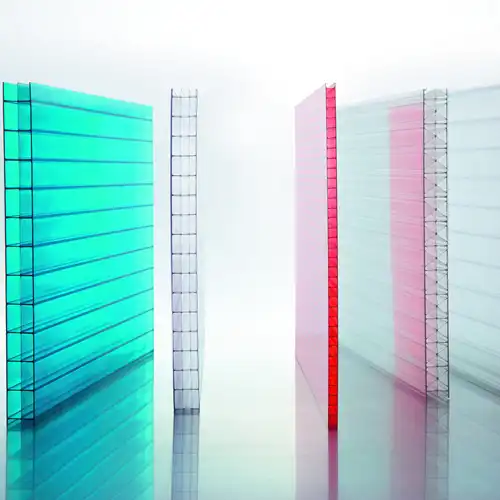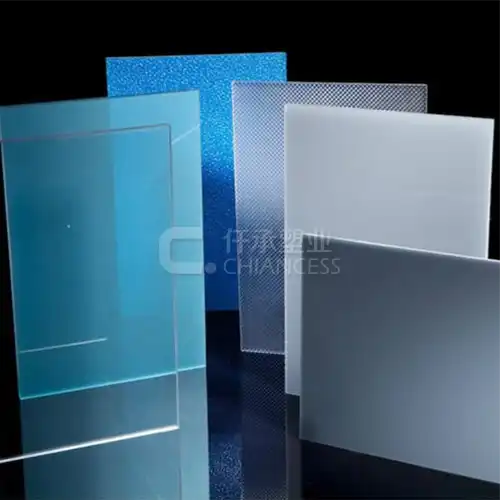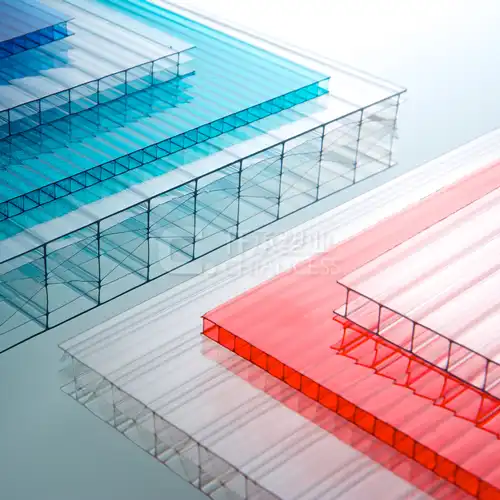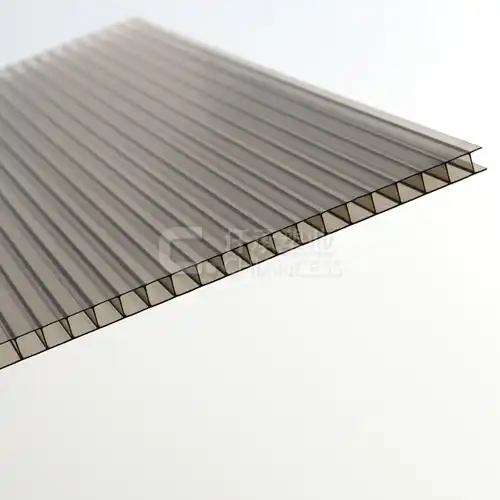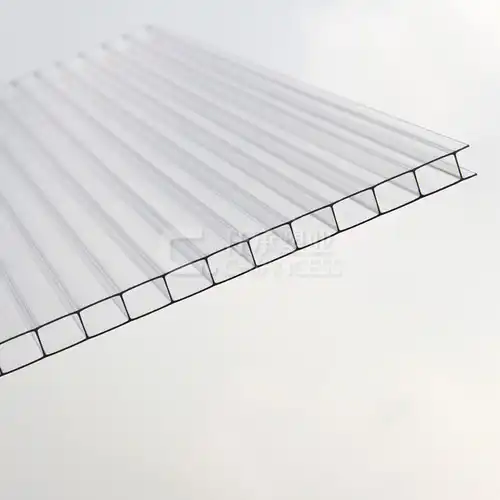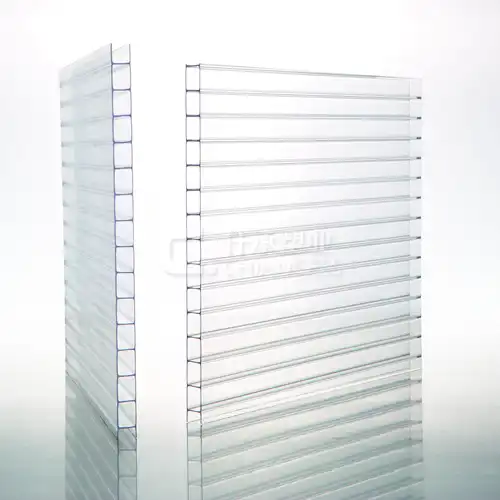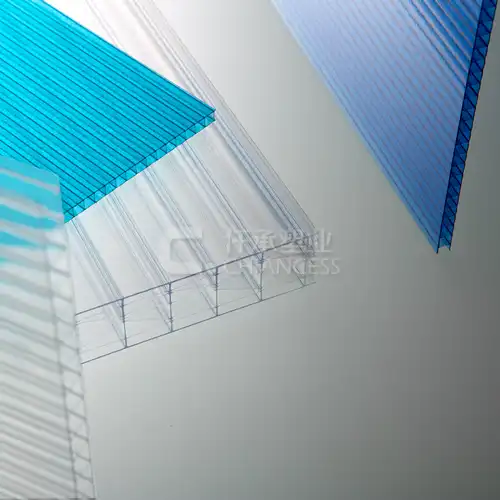July 29, 2024
Multiwall polycarbonate sheets are renowned for their remarkable strength and durability. These sheets, composed of multiple layers of polycarbonate material separated by air spaces, offer superior impact resistance, making them significantly tougher than traditional glass and even other plastic materials. The layered structure not only enhances their strength but also provides excellent thermal insulation, making them an ideal choice for a wide range of applications, from greenhouse glazing to architectural roofing and cladding. The combination of high impact resistance, lightweight nature, and thermal insulation properties underscores the robustness and versatility of multiwall polycarbonate sheets.
What Is Multiwall Polycarbonate Sheet?
Multiwall polycarbonate sheet is a lightweight and durable thermoplastic material that consists of multiple layers of polycarbonate sheets joined together by vertical ribs.
These sheets are commonly available in double-wall, triple-wall, and even higher configurations, offering different levels of strength and thermal insulation.The multiple layers of polycarbonate sheets are typically connected by vertical ribs or channels, creating a hollow structure. This hollow structure provides several advantages:
- Enhanced Strength: The multi-layer construction, coupled with the vertical ribs, provides increased strength and rigidity compared to single-layer polycarbonate sheets.
- Improved Thermal Insulation: The hollow spaces between the layers act as thermal insulators, reducing heat transfer and contributing to energy efficiency.
- Lightweight: Despite their strength and insulation properties, multiwall polycarbonate sheets are lightweight and easy to handle, making them suitable for a variety of applications.
- Light Transmission: Polycarbonate is a highly transparent material, and multiwall polycarbonate sheets maintain this transparency.
They allow natural light to pass through while diffusing it, reducing glare and creating a more comfortable and evenly lit environment.
Overall, Multiwall Polycarbonate Sheets offer a unique combination of strength, thermal insulation, lightweight design, and light transmission, making them ideal for various applications such as skylights, greenhouses, roofing, and cladding.
What Makes Multiwall Polycarbonate Sheets Strong?
Multiwall polycarbonate sheets derive their strength from several key factors:
2.1.Structural Design
The multiwall structure of these polycarbonate sheets provides inherent strength. The vertical ribs between the layers act as structural supports, distributing weight evenly across the sheet. This design helps to withstand heavy loads and impact without breaking or shattering.
2.2.Impact Resistance
Multiwall polycarbonate sheets are renowned for their exceptional impact resistance, which is attributed to two key factors:
- The Flexible Nature of Polycarbonate: Polycarbonate is an inherently flexible material, allowing it to absorb and dissipate impact energy without shattering or cracking. This flexibility makes multiwall polycarbonate sheets highly resistant to damage from hailstones, falling branches, and other impact forces.
- Cushioning Effect of Air Spaces: The hollow structure of multiwall polycarbonate sheets creates air spaces between the layers. These air spaces act as a cushion, absorbing and dissipating impact energy before it can reach the inner layers of the sheet. This cushioning effect further enhances the impact resistance of multiwall polycarbonate sheets.
Compared to traditional glass or acrylic sheets, multiwall polycarbonate sheets offer significantly higher impact resistance.
Glass is brittle and can easily shatter upon impact, while acrylic sheets, while more flexible than glass, are still susceptible to cracking and breakage.
Multiwall polycarbonate sheets, on the other hand, can withstand significant impact forces without sustaining damage, making them an ideal choice for applications where impact resistance is a primary concern.
2.3.Material Properties
Polycarbonate itself is a strong material with high tensile strength and flexural strength. It can bend without breaking and return to its original shape, which contributes to its durability and long lifespan.
Applications of Multiwall Polycarbonate Sheets
Multiwall polycarbonate sheets find applications across various industries due to their strength, versatility, and other properties. Here are some common uses:
3.1.Greenhouses and Agricultural Structures
In agriculture, multiwall polycarbonate sheets are widely used for greenhouse construction. Their strength allows them to withstand wind, snow loads, and hail, while their light transmission properties promote plant growth. They offer better insulation than glass, reducing heating costs in colder climates.
3.2.Architectural Glazing
In architectural glazing applications, multiwall polycarbonate sheets are commonly used in skylights, canopies, and atriums.
They offer several advantages over traditional glass for these applications:- Natural Daylighting: Multiwall polycarbonate sheets are highly transparent, allowing natural light to penetrate buildings while diffusing it to reduce glare. This contributes to a more comfortable and evenly lit environment.
- Reduced Solar Heat Gain: The hollow structure of multiwall polycarbonate sheets provides thermal insulation, reducing solar heat gain compared to single-layer polycarbonate or glass. This helps maintain a more comfortable indoor temperature, reducing cooling costs.
- Energy Efficiency: The thermal insulation properties of multiwall polycarbonate sheets contribute to energy efficiency in buildings. By reducing heat transfer, they help lower heating and cooling costs.
- Strength and Light Weight: Multiwall polycarbonate sheets are lightweight yet highly strong and durable. This makes them easier to handle, transport, and install compared to glass, reducing labor costs and installation time.
In addition to these benefits, polycarbonate sheet multiwalls are also resistant to impact, UV radiation, and yellowing, ensuring long-lasting performance and durability.
Their versatility and cost-effectiveness make them an ideal choice for a wide range of architectural glazing applications.
3.3.Industrial Roofing and Cladding
In industrial settings, multiwall polycarbonate sheets serve as roofing and cladding materials for warehouses, factories, and sports facilities. They provide a durable and economical solution with excellent light transmission and UV protection. Their strength ensures long-term performance in harsh weather conditions.
Conclusion
In conclusion, multiwall polycarbonate sheets offer exceptional strength due to their unique structural design, impact resistance, and the inherent properties of polycarbonate material. When selecting polycarbonate multiwall sheets for your project, it is important to consider the specific requirements and environmental factors that may impact their performance. For example, if high load-bearing capacity is required, thicker sheets with reinforced ribs may be necessary. Similarly, if light transmission is a priority, sheets with higher transparency and UV protection should be considered.
For more information about multiwall polycarbonate sheets or to discuss your specific project needs, please contact us at simon@chiancess.com.
References:
Chen, C., & Liu, S. (2019). Advanced Polycarbonate Structures in Architecture. Springer.
Zhang, Q., & Wang, L. (2018). Thermal Performance of Multiwall Polycarbonate Sheets. Journal of Building Materials.
Gu, J., & Li, J. (2019). High Impact Resistance of Multiwall Polycarbonate Sheets. Polymer Engineering and Science.
Johnson, M., & Brown, K. (2017). UV Protection in Polycarbonate Materials. Society of Plastics Engineers.
Lee, Y., & Kim, D. (2018). Lightweight Materials for Architectural Glazing. John Wiley & Sons.
Wang, X., & Wu, Y. (2016). Design and Installation of Polycarbonate Roofing. CRC Press.
Patel, A., & Rao, K. (2019). Application of Multiwall Polycarbonate Sheets in Greenhouse Engineering. Springer Nature.
.webp)
